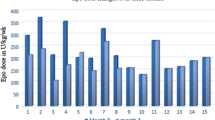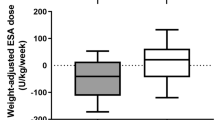Abstract
Unlike iron therapy, folate use is not a standard of care in hemodialysis (HD) patients. Despite iron repletion, poor response to erythropoietin (EPO) treatment is common. Theoretical evidence for folate deficiency (FD) includes chronic blood loss, inflammation, malnutrition, and nutrient loss during dialysis. Due to poor diagnostic standards, early studies failed to establish a role for FD in EPO resistance. Given that hematological response to therapeutic intervention is the gold standard for FD, its diagnosis was therefore based on composite scoring of RBC and/or folate indices.
Fifteen subjects (8–20 years) on chronic HD were enrolled in this study. No folate supplement was given in the first six months. Thereafter, 5-mg folic acid was administered orally after HD sessions over a six-month period. Folate indices before and after treatment were compared using percentage differences and paired t-tests. After folate use, the mean Hb increased by 11.4%, while MCV and RDW were reduced. Similarly, 4 of the 15 subjects each had a ≥20% rise in Hb and a ≥5% reduction in MCV, while 46.7% had a ≥2.5% reduction in RDW. Mean RBC folate increased by 24%, while FD scores reduced from 3.8±1.2 to 0.4±0.7, and the EPO requirement by 90%.
In contrast to previous studies, 26.7% of study subjects met the criteria for FD. Furthermore, the substantial (post-folate) reduction in the EPO requirement validates the need for therapeutic intervention, and therefore the presence of functional FD in the population.

Similar content being viewed by others
References
Collins AJ, Li S, St Peter WL, Ebben J, Roberts T, Ma JZMW (2001) Death, hospitalization, and economic associations among incident hemodialysis patients with hematocrit levels of 36–39%. J Am Soc Nephrol 12:2465–2473
Ross SD, Fahrbach K, Frame D, Scheye R, Connelly JE, Glaspy J (2003) The effect of anemia treatment on selected health-related quality of life domains: a systematic review. Clin Ther 25:1786–1805
Revicki D, Brown R, Feeny D, Henry D, Teehan B, Rudnick M, Benz R (1991) Health related quality of life with human erythropoietin treatment for predialysis chronic renal disease patients. Am J Kidney Dis 25:548–554
Eschbach JW, Varma A, Stivelman JC (2002) Is it time to for a paradigm shift? Is erythropoietin deficiency still the main course of renal anaemia? Nephrol Dial Transplant 17(Suppl 5):2–7
The US Recombinant Human Erythropoietin Predialysis Study Group (1991) Double-blind, placebo-controlled study of therapeutic use of recombinant human erythropoietin for anemia associated with chronic renal failure in predialysis patients. Am J Kidney Dis 18:50–59
National Kidney Foundation (2000) K/DOQI clinical practice guidelines for anemia of chronic kidney disease. Am J Kidney Dis 37:S182–S238
Besarab A, Amin N, Ahsan M, Vogel SE, Zazuwa G, Frinak S, Zazra JJ, Anandan JV, Gupta A (2000) Optimization of epoietin therapy with intravenous iron therapy in hemodialysis patients. J Am Soc Nephrol 11:530–538
Eschbach JW, Abdulhadi MH, Browne JK, Delano BG, Downing MR, Egrie JC, Evans RW, Friedman EA, Graber SE, Haley NR, et al (1989) Recombinant human erythropoietin in anemic patients with end stage renal disease. Results of phase II multicenter clinical trial. Ann Intern Med 111:992–1000
Allen RH (2000) Megaloblastic anemias. In: Goldman L (ed) Cecil textbook of medicine, 21st edn. WB Saunders Co, Philadelphia, PA
Leblanc M, Pichette V, Geadahy D, Ouimet D (2000) Folic acid and pyridoxal-5′-phosphate losses during high-efficiency hemodialysis in patients without hydrosoluble vitamin supplementation. J Ren Nutr 10:196–201
Lasseur C, Parrot F, Delmas Y, Level C, Ged C, Redonnet-Vernhet I, Montaudon D, Combe C, Chauveau P (2001) Impact of high-flux/high-efficiency dialysis on folate and homocysteine metabolism. J Nephrol 14:32–35
Galluci MT, Lubrano R, Meloni C, Morosetti M, Manca di Villahermosa S, Scoppi P et al (1999) Red blood cell membrane lipid peroxidation and resistance to erythropoietin therapy in hemodialysis patients. Clin Nephrol 52:239–245
Cooper AC, Mikhail A, Lethbridge MW, Kemeny DM, MacDougall IC (2003) Increased expression of erythropoiesis inhibiting cytokines (IFN-gamma, TNF-alpha, IL-10, and IL-13) by T cells in patients exhibiting a poor response to erythropoietin therapy. J Am Soc Nephrol 14:1776–1784
Lin CL, Huang CC, Yu CC, Wu CH, Chang CT, Hsu HH, Hsu PY, Yang CW (2002) Improved iron utilization and reduced erythropoietin resistance by on-line hemodiafiltration. Blood Purif 20:349–356
Varagunam M, McCloskey DJ, Sinnot PJ, Raftery MJ, Yaqoob MM (2003) Angiotensin-converting enzyme gene polymorphism and erythropoietin requirement. Perit Dial Int 23:111–115
Seeherunvong W, Rubio L, Abitbol CL, Montane B, Strauss J, Diaz R et al (2001) Identification of poor responders to erythropoietin among children undergoing hemodialysis. J Pediatr 138:710–714
Le Meur Y, Lorgeot V, Comte L, Szelag JC, Aldigier JC, Leroux-Robert C, Praloran V (2001) Plasma levels and metabolism of AcSDKP in patients with chronic renal failure: relationship with erythropoietin requirements. Am J Kidney Dis 38:510–517
Hershko C, Grossowicz N, Rachmilewitz M, Kestern S, Izak G (1975) Serum and erythrocyte folates in combined iron and folate deficiency. Am J Clin Nutrition 28:1217–1222
Paine CJ, Hargrove MD Jr, Eichner ER (1976) Folic acid binding protein and folate balance in uremia. Arch Int Med 136:756–760
Phekoo K, Williams Y, Schey SA, Andrews VE, Dudley JM, Hoffbrand AV (1979) Folate assays: serum or red cell? J R Coll Physicians Lond 31:291–295
Shelnutt KP, Kauwell GP, Chapman CM, Gregory JF 3rd, Maneval DR, Browdy AA, Theriaque DW, Bailey LB (2003) Folate status response to controlled folate intake is affected by the methylenetetrahydrofolate reductase 677C-->T polymorphism in young women. J Nutr 133:4107–4111
Fodinger M, Dierkes J, Skoupy S, Rohrer C, Hagen W, Puttinger H, Hauser AC, Vychytil A, Sunder-Plassmann G (2003) Effect of glutamate carboxylase II and reduced folate carrier polymorphisms on folate and total homocysteine concentrations in dialysis patients. J Am Soc Nephrol 14:1314–1319
Owen WE, Roberts WL (2003) Comparison of five automated serum and whole blood folate assays. Am J Clin Pathol 120:121–126
Philpott N, Kelleher BP, Smith OP, O’Broin SD (2001) High serum folates and the simplification of red cell folate analysis. Clin Lab Haematol 23:15–20
Lilien M, Duran M, Van Hoeck K, Poll-The BT, Schroder C (1999) Hyperhomocyst(e)inaemia in children with chronic renal failure. Nephrol Dial Transplant 14:366–368
Hudspeth M, Symons H (2002) Hematology. In: Gunn VL, Nechyba C (eds) The Harriet Lane handbook, 16th edn. Mosby Inc, Philadelphia, PA
Kalantar-Zadeh K, Kopple JD, Block G, Humphreys MH (2001) A malnutrition-inflammation score is correlated with morbidity and mortality in maintenance hemodialysis patients. Am J Kidney Dis 38:1251–1263
Bamonti-Catena F, Buccianti G, Porcella A, Como G, Finnazzi S, Malolo AT (1999) Folate measurements in patients on regular hemodialysis treatment. Am J Kidney Dis 33:492–497
Merouani A, Lambert M, Delvin EE, Genest J, Robitaille P, Rozen R (2001) Plasma homocysteine concentration in children with chronic renal failure. Pediatr Nephrol 16:805–811
Korzets A, Ori Y, Chagnac A, Weinstein T, Herman M, Zevin D, Malachi T, Gafter U (2000) Erythropoietin, folic acid deficiency and hyperhomocysteinemia: is there a possible relationship in chronically hemodialyzed patients? Clin Nephrol 53:48–54
Haltmayer M, Mueller T, Poelz W (2002) Erythrocyte mean cellular volume and its relation to serum homocysteine, vitamin B12 and folate. Acta Med Austriaca 29:57–60
Savage DG, Ogundipe A, Allen RH, Stabler SP, Lindenbaum J (2000) Etiology and diagnostic evaluation of macrocytosis. Am J Med Sci 319:343–352
Sheingold S, Churchill D, Muirhead N, Laupacis A, Labelle R, Goeree R (19929 The impact of recombinant human erythropoietin on medical care costs for hemodialysis patients in Canada. Soc Sci Med 34:983–991
Martin I, Obrador A, Gibert MJ, Hernanz A, Fuster A, Pintos C, Garcia A, Tur J (2003) Folate status and a new repletion cut-off value in a group of healthy Marjocan women. Clin Nutr 22:53–58
Farid FRA, Faheem MS, Heshmat NM, Shaheen KY, Saad SS (2004) Study of homocysteine status in children with chronic renal failure. Am J Nephrol 24:289–295
Kang HG, Lee BS, Hahn H, Lee JH, Ha IS, Cheong HI, Choi Y (2002) Reduction of plasma homocysteine by folic acid in children with chronic renal failure. Pediatr Nephrol 17:511–514
Van Wyck DB (2000) Management of early renal anaemia: diagnostic work up, iron therapy, epoietin therapy (review). Nephrol Dial Transplant 15(Suppl 3):36–39
Grimes DA, Schulz KF (2002) Bias and causal associations in observational research (review). Lancet 359:248–252
Acknowledgements
This study was presented in abstract form at the Pediatric Academic Society Annual Meeting, Washington DC, May 2005. Oluwatoyin Fatai Bamgbola was supported by NIDDK Training Grant No. 9-526-3740. We appreciate the assistance of Dr. Martin Turman, Dr. James Wenzl, Dr. Kathleen O’Neil of Department of Pediatrics, Oklahoma University Health Science Center, OK, USA, for their assistance in proofreading the manuscript.
Author information
Authors and Affiliations
Corresponding author
Rights and permissions
About this article
Cite this article
Bamgbola, O.F., Kaskel, F. Role of folate deficiency on erythropoietin resistance in pediatric and adolescent patients on chronic dialysis. Pediatr Nephrol 20, 1622–1629 (2005). https://doi.org/10.1007/s00467-005-2021-7
Received:
Revised:
Accepted:
Published:
Issue Date:
DOI: https://doi.org/10.1007/s00467-005-2021-7




